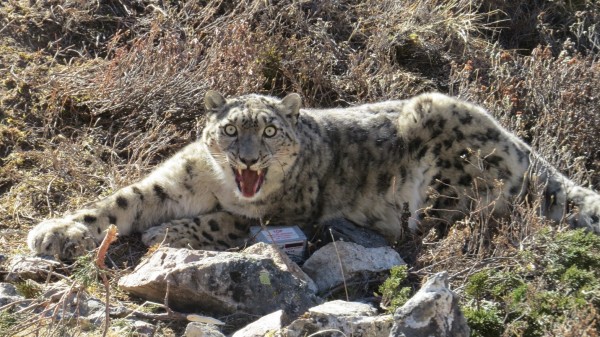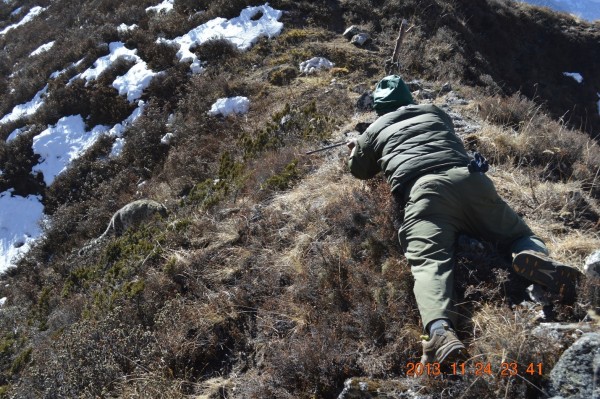Spotlight on the snow leopard: The Day I Tricked the Ghosts of the Mountains (Part 2)
This holiday season, WWF is introducing six new species for you to adopt and take home, including the snow leopard. We’re bringing you a special six-part blog series on the snow leopard, the most mysterious member of the world’s big cats.
You can read part one of Dr. Rinjan Shrestha’s field story here.
As per the protocol, the chairman of the local Snow Leopard Conservation Committee, Mr. Himali Chungda Gurung, left the camp site to see if it was actually a snow leopard that had triggered the snare. In the meantime, we also spotted a movement around the same trap site from our position at the base camp. After carefully scanning the area through our binoculars and spotting scope, it became apparent that it was an adult snow leopard. Because he was roaming at a considerable distance from the trap site, I thought he might have gotten rid of the snare. That would be the worst thing to happen in a situation like this.
A moment later, a reassuring call from Himali over a walkie-talkie felt like music to my ears. He spotted another snow leopard trapped in a snare. As a practicing biologist, it immediately occurred to me why on earth there should be two adult snow leopards staying together, for we know that the species spend a solitary lifestyle outside of the mating season and the month of November is too early for them to mate. Since we had more important tasks ahead, rather than pondering over this interesting ecological question, I assured myself that I would get into depth on the issue later.
So as soon as we received a message from Himali, I prepared to leave the camp along with two other companions; the wildlife technician Mr. Nandu Ram Acharya, and WWF-Mountain Research Officer Mr. Kamal Thapa. Out of sheer excitement, I reached the trap site within half an hour that would otherwise take me one and half hour. Himali, Kamal and I positioned ourselves at about 20 meters from the snow leopard and there was a rock out-cropping between us and the snow leopard – a perfect site to avoid the line of sight and thus to make the snow leopard not too agitated. We then realized that Nandu was nowhere to be seen. As he mostly worked with tigers in the plains of low lands, I could make out why he was left behind, here in the rugged Himalayas. As we waited for him, Himali kept on asking if he should go and carry Nandu on his back, uphill to our location. He appeared to be freaked out that snow leopard would break loose the snare at any moment. I was certain that that was highly unlikely and tried to calm him down by suggesting him to take deep breaths.
It was already 9 a.m. when all of us reached the site that was deemed to be an excellent vantage point to fire the dart. As Nandu was still trying to catch his breath after the strenuous climb, I told him to take as much time as needed before he shoots the dart at the snow leopard. We wanted to be absolutely sure that the dart would land at the rump of the snow leopard. It was crucial that we would not miss the target as the sedatives that we were using could be very lethal. As we moved closer to the snow leopard, he became very agitated and we stopped within the distance of 10m from him. It took another 30 minutes for us to fire the dart as we wanted both the wind and snow leopard to settle down. The dart landed at the right side of the rump and he became unconscious after eight minutes. I checked the depth of anesthesia by poking his tail with my walking stick. As I did not receive any response from him, I asked the team to come over to undertake the routine procedure leading up to fitting of satellite GPS collars. On the basis of its dentition and body weight (i.e, 40 kg) and length (1.90 m nose to tip of the tail), we judged him to be a four to five year old adult snow leopard. Dr. Gary Koelhler, Carnivore Biologist, who accompanied us to help with setting up of snares later determined it as a male snow leopard. We named this snow leopard “Ghangjenjwenga” after the local mountain deity.
As the capture site was not suitable for his safe release, we moved him to a more secure site downhill. Dr. Bal Krishna Giri administered the antidote to wake him up. Nearly 15 minutes later, Ghangjenjwenga regained consciousness and started shaking off his head vigorously. He then slowly got up and ran uphill towards the crevice between two large boulders. We remained there for half an hour and returned to our camp after making sure that Ghangjenjewenga’s recovery was successful.
Since then, I have been receiving e-mail messages from the GPS collar on Ghangjenjwenga every four hours, which tells me his whereabouts in the Kanchhenjunga region. Over the period, he took a sojourn to India on three occasions and crossed a mountain pass nearly 5900 m elevation. To the best of my knowledge, this could be the highest altitude documented for any species of cat around the globe.
At this point, you may be wondering that why we are engaged in the satellite telemetry of snow leopards. One of the primary bottlenecks to conserve critically endangered snow leopard is the lack of knowledge about their ecology and behavior. For instance, we do not know the types of habitats that the snow leopard prefers to live and breed in or how large an area is needed to be brought under protection to conserve the snow leopard. We also need to know the nature and extent of the impact of both anthropogenic and climatic stressors along with effective measures to curb ongoing rampant poaching and retaliatory killing of snow leopards. With the help of satellite telemetry operation, we plan to obtain answers to these questions and thus to devise robust strategies to conserve snow leopard populations and their habitat for generations to come.




